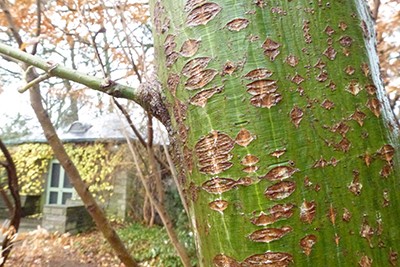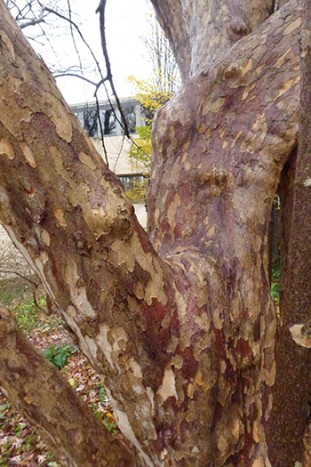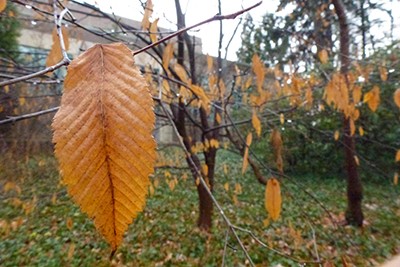Plants of the Week: December 5
Acer rufinerve
The Maphouse is a small peculiar building tucked into the wooded edge of the Parrish West Circle between the Lang Performing Arts Center (LPAC) and the Scott Outdoor Amphitheater. Planted around it is an assortment of oddities, each with its own story. One tree in particular caught my attention with its green bark dappled with large brown lenticels and silver vertical striations. This tree, Acer rufinerve, is a Japanese native maple in the family Sapindaceae, not entirely dissimilar to our native Acer pennsylvanicum. The bark has high concentrations of photosynthetic material giving it a consistent green color striped vertically with silver. The small lenticels on the bark stretch and grow with age making interesting brown diamond patterns that really pop during bleak winter months. photo credit: J. Bickel
Cornus officianalis
Continuing my adventure behind the Maphouse, approaching the Buttonweiser Terrace, a small secluded stone patio between the Lang Performing Arts Center and the Lang Music Building, I came across another interesting bark specimen. Cornus officinalis is a medium-sized multi-stemmed tree, native to Eastern Asia, with patchy sloughing bark similar to sycamore. It is very similar to the European native Cornus mas except that it produces small yellow flowers one week earlier and the bright red, astringent, edible fruits are slightly smaller. Commonly called the Japanese cornelian cherry, sources say the name comes from the Latin cornu- meaning horn and officinalis, used to denote historic herbal or medicinal use. photo credit: J. Bickel
Acer carpinifolium
Continuing my brief foray along the edge of the Crum Woods near LPAC and the Maphouse, I came across another oddity. Were it not for someone pointing this out to me, I would have passed this exceptional maple off as a native Hornbeam (Carpinus caroliniana). Superficially resembling a hornbeam, the Acer carpinifolium is a true oddity and an exemplary model of the extremes in variability of leaf morphology in the genus Acer. Upon closer inspection however, they do differ in leaf arrangement (Carpinus being arranged in a spiral whereas Acer demonstrates an opposite branching pattern), as well as the appearance of the bark. Acer carpinifolium has burgundy brown bark with evenly distributed lenticels and simpler rounded appearance, while Carpinus caroliniana has grayish bark and branch shape often described as “muscular” or “sinewy” due to its long curving ridges resembling the muscles of animals. photo credit: J. Bickel








No Comments